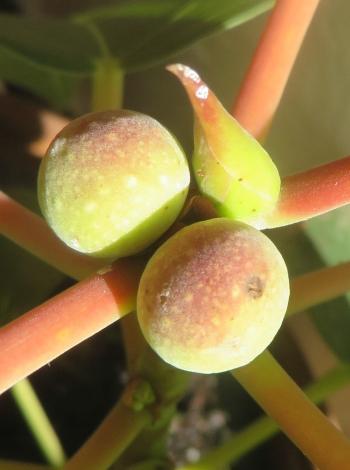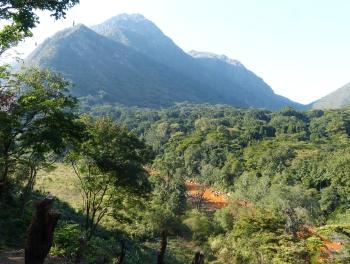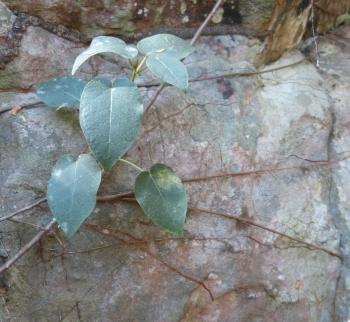Ficus muelleriana
Ficus muelleriana C.C.Berg.
Family: Moraceae
Common names: wandering rock-fig, Chimanimani rock-fig, Mueller’s climbing fig (Eng.); chimanimanirotsvy (Afr.)
Introduction
Ficus muelleriana represents a fairly recent discovery. It is a rare, cliff-dwelling, scandent shrub, with beautiful heart-shaped leaves, reddish leaf petioles and reddish fruits. Endemic to the mineral-poor cliffs of the lower slopes of the Chimanimani Mountains in western Mozambique, close to the Zimbabwe border.

Description
Description
Ascending, sparsely branched, evergreen, scandent shrub, up to 1.5 m tall. Branches terete, 4–7 mm in diameter, green at first, minutely pubescent, becoming reddish brown and greyish when mature and hairless, basal branches up to 10 mm in diameter; internodes 7–20 mm apart. Adventitious roots thin and reddish at first, becoming greyish and stem-like, forming a network of roots clinging to the rock face and entering crevices. Leaves in upper parts of stems, alternate, sometimes somewhat crowded towards the ends of the branches, heart-shaped (cordate) 65–100 × 45–65 mm, leathery, pale to dark green, somewhat glossy, the blade ascending to horizontal or drooping with yellowish green reticulate veining, prominent on the lower surface; the main vein to the tip of the leaf and 2 basal veins from the base of the leaf, forming a v-shape, the minor veins radiating like branches on a tree; upper surface hairless; lower surface densely and minutely pubescent on veins and densely beset with white dots in between veins, the main vein becoming glabrous with age; base cordate; margin entire to obscurely and shallowly toothed, minutely pubescent; petioles (20–)45–50(–60) long and 3.0–3.5 mm in diameter, ascending spreading, yellowish green to reddish, surface minutely pubescent; the leaf end (apex) acute to subacute. Leaf stipules triangular 26 × 11 mm, fleshy and soon deciduous.

Fruits (figs) in shortly stalked pairs in leaf axils of the current year’s growth, roundish, 8–9 mm long and up to 11 mm in diameter, reddish green, the surface minutely puberulous; the pore at the end of the fruit (receptacle) star-shaped and not raised. Flowering and fruiting time: Can be at any time of the year, but more so in summer.

Conservation Status
Status
Ficus muelleriana is a rare endemic of the southern and eastern portion of the Chimanimani Mountains in western Mozambique. Its sheer, cliff-face habitat provides efficient protection from herbivores and most threats.

Distribution and habitat
Distribution description
Ficus muelleriana grows on quartzitic, mineral-deprived. sandstone cliffs and boulders, at about 500 m in altitude, exposed or in partial shade. Near Haroni Gorge the southern end of the Chimanimani Mountains, plants have been observed on sheer cliffs (northern aspects) in moist savanna together with other cliff-dwelling plants such as Aloe ballii and A. cameronii, Kleinia chimanimaniensis, Rhipsalis baccifera, Zamiaculcas zamiifolia, Cryptostephanus vansonii and Ficus craterostoma. During the dry season, the lower leaves wither and becomes deciduous, the plants, however, remain evergreen. The climate is warm and humid in summer and winter, but somewhat cooler in winter, and without frost. Rainfall in its habitat is high (about 1 000–1 500 mm per annum), which occurs mainly from spring to autumn.

Derivation of name and historical aspects
History
Ficus muelleriana was discovered during the 1980s by Mr Rich, east of the Makurupini Waterfall, in Mozambique. It was named in 1988 by the Dutch botanist Cornelius Berg (1934–), in the Kew Bulletin, after Tom Mueller (1932–), Swiss horticulturist who served as curator of the National Botanical Garden Harare, Zimbabwe from 1862–1993 and who also collected this species near the Makurupini Waterfall (Glen & Germishuizen 2003).
The genus Ficus has a cosmopolitan distribution in the tropical and subtropical parts of the world, with about 800 species (about 100 species in Africa), all with a milky latex. Figs usually have large stipules protecting the growing buds. Figs belongs to the Moraceae family. They are well represented in southern Africa with at least 35 species. Well known species of cultivation includes the edible fig (Ficus carica) (from southeastern Europe), the sycamore fig (F. sycomorus) from the African savannas and the ticky creeper (Ficus pumila) from Japan. Figs provide food to many animals including mainly primates, birds and bats. Fruits are known as a syconium, consisting of a modified hollowed out inflorescence, the small seeds imbedded on the walls of the fig. Some figs are known for their adventitious roots which grows opportunistically. The wandering rock-fig belongs to a group of figs associated with rocks. This includes the small- and large-leaved rock fig (Ficus tettensis and F. abutilifolia). The latter 2 are small trees or sometimes large shrubs.
Ecology
Ecology
Little is known about the pollination of Ficus muelleriana. The pollinators of figs are dwarf wasps that are usually associated only with the host species of Ficus. The fruits when ripe, are reddish and visible and should certainly be dispersed by local frugatory birds, dropping their excretion on the rock face. Plants grown in containers at the author’s home in Stellenbosch, have been producing figs all year around.

Plants grow scattered in crevices of minerally deprived, quartzitic, sandstone cliffs in full sun or shade of trees or boulders. Growing season is in the warmer months. The seed germinates in crevices and, the scandent branches sending out roots as they grow along, and which enables it to cling to the rock face. This enables the plant to be mobile, and the plant can thus travel short distances (the older branches dying off), the younger branches rooting as they grow. It has a slow rate of growth, the initial adventitious roots are reddish and grow tightly against the rock face and the network of roots will grow into crevices, anchoring the plant, as well as obtaining moisture and minerals from debris in the crevices. Crevices provide sufficient moisture throughout the dry, winter season. Its out-of-reach cliff face habitat, ensures protection from larger herbivores and fires. Advantageousness of its wandering nature, is that it can occupy new territory with sufficient moisture and minerals in its already mineral–deprived, sandstone habitat.
Uses
Use
Only horticultural use is known.

Growing Ficus muelleriana
Grow
Ficus muelleriana shows horticultural promise as a container or hanging basket plant. In the garden, plants are best grown among gabions and well-watered until establishment. Prune when necessary. It grows well in shallow soil and is best in sandy, mineral-poor soil. It is sensitive to frost and in regions where frost is a problem, best grown as a container plant in a protected environment. In southern Africa it is better suited for warmer, moist, bushveld regions along the eastern coastal parts of southern Africa (Van Jaarsveld 2010).
Cuttings can be rooted in sand, or a mixture of sand and peat or polystyrene. Cuttings of about 10 to 15 cm long can be made from early summer to autumn. Rooting is rapid and plants can soon be transferred to individual containers. Plants have reacted well to organic feeding such as sea-grow.
References
- Berg, C.C. 1988. New taxa and combinations in Ficus (Moraceae) in Africa. Kew Bulletin 43,1: 77–97.
- Burrows, J. & Burrows, S. 2003. Figs of southern and south-central Africa. Umdaus Press, Hatfield.
- Germishuizen, G. & Meyer, N.L. (eds) 2003. Plants of southern Africa: an annotated checklist. Strelitzia 14. National Botanical Institute, Pretoria.
- Glen, H.F. & Germishuizen, G. (compilers). 2010. Botanical exploration of southern Africa, edition 2. Strelitzia 26. South African National Biodiversity Institute, Pretoria.
- Van Jaarsveld, E.J. 2010. Waterwise gardening in South Africa and Namibia. Struik, Cape Town.
Credits
E.J. van Jaarsveld
Kirstenbosch National Botanical Garden (Retired)
Babylonstoren Farm
Extraordinary senior lecturer and researcher, Department of Biodiversity and Conservation, University of the W. Cape.
December 2017
Plant Attributes:
Plant Type: Scrambler
SA Distribution:
Soil type: Sandy
Flowering season: Sporadic/All year
PH: Acid
Flower colour: Red
Aspect: Full Sun, Shade, Morning Sun (Semi Shade), Afternoon Sun (Semi Shade)
Gardening skill: Challenging
Special Features:
Horticultural zones







Rate this article
Article well written and informative
Rate this plant
Is this an interesting plant?
Login to add your Comment
Back to topNot registered yet? Click here to register.